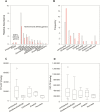Depot Medroxyprogesterone Acetate and the Vaginal Microbiome as Modifiers of Tenofovir Diphosphate and Lamivudine Triphosphate Concentrations in the Female Genital Tract of Ugandan Women: Implications for Tenofovir Disoproxil Fumarate/Lamivudine in Preexposure Prophylaxis
- PMID: 31131846
- PMCID: PMC7146007
- DOI: 10.1093/cid/ciz443
Depot Medroxyprogesterone Acetate and the Vaginal Microbiome as Modifiers of Tenofovir Diphosphate and Lamivudine Triphosphate Concentrations in the Female Genital Tract of Ugandan Women: Implications for Tenofovir Disoproxil Fumarate/Lamivudine in Preexposure Prophylaxis
Abstract
Background: Effective concentrations of antiretrovirals in the female genital tract (FGT) are critical for suppression of viral shedding or effective preexposure prophylaxis. The disposition of tenofovir diphosphate (TFV-DP) and emtricitabine triphosphate (FTC-TP) in the FGT have been previously described. Despite widespread use, however, lamivudine triphosphate (3TC-TP) exposure in the FGT is unknown. Depot medroxyprogesterone acetate (DMPA) and vaginal dysbiosis have been implicated in increased risk of human immunodeficiency virus (HIV) acquisition, but whether they alter TFV-DP or 3TC-TP exposure, and therefore compromise prevention efficacy, is unknown.
Methods: Fifty premenopausal women living with HIV in Kampala, Uganda, and receiving daily tenofovir disoproxil fumarate/lamivudine were recruited. Ectocervical biopsies were obtained for quantification of TFV-DP and 3TC-TP using liquid chromatography-mass spectrometry. 16S ribosomal RNA gene sequencing was performed on DNA extracted from vaginal swabs. Wilcoxon rank-sum was used to test for differences between contraceptive groups.
Results: 3TC-TP concentrations were on average 17-fold greater than TFV-DP concentrations in cervical tissues. TFV-DP concentrations in cervical biopsies were 76% greater in DMPA users compared with women using nonhormonal contraception (n = 23 per group). Abundance of Lactobacillus in vaginal swabs was correlated with 3TC-TP concentrations in cervical tissues.
Conclusions: We found that TFV-DP concentrations were significantly greater in DMPA users compared with women using nonhormonal contraception, suggesting that prevention efficacy is unlikely to be compromised by DMPA use. Similar to reports of FTC-TP, 3TC-TP exposure was significantly greater than TFV-DP in cervical tissue and was correlated with abundance of Lactobacillus. These data support lamivudine as an option for preexposure prophylaxis.
Clinical trials registration: NCT03377608.
Keywords: DMPA; HIV; PrEP; lamivudine; microbiome; tenofovir.
© The Author(s) 2019. Published by Oxford University Press for the Infectious Diseases Society of America. All rights reserved. For permissions, e-mail: journals.permissions@oup.com.
Figures


Similar articles
-
Association of tenofovir diphosphate and lamivudine triphosphate concentrations with HIV and hepatitis B virus viral suppression.AIDS. 2024 Mar 1;38(3):351-362. doi: 10.1097/QAD.0000000000003764. Epub 2023 Nov 22. AIDS. 2024. PMID: 37861682 Free PMC article.
-
Measurements of tenofovir-diphosphate and emtricitabine-triphosphate concentrations in dried blood spots of people receiving pre-exposure prophylaxis for HIV with co-formulated tenofovir disoproxil fumarate and emtricitabine.J Microbiol Immunol Infect. 2025 Aug;58(4):414-421. doi: 10.1016/j.jmii.2025.03.002. Epub 2025 Mar 8. J Microbiol Immunol Infect. 2025. PMID: 40087092
-
Intracellular pharmacokinetics of tenofovir diphosphate, carbovir triphosphate, and lamivudine triphosphate in patients receiving triple-nucleoside regimens.J Acquir Immune Defic Syndr. 2005 Aug 1;39(4):406-11. doi: 10.1097/01.qai.0000167155.44980.e8. J Acquir Immune Defic Syndr. 2005. PMID: 16010161
-
The effectiveness of tenofovir-based pre-exposure prophylaxis for prevention of HIV acquisition among sub-Saharan African women at high risk: a systematic review.Pan Afr Med J. 2021 Mar 26;38:308. doi: 10.11604/pamj.2021.38.308.26014. eCollection 2021. Pan Afr Med J. 2021. PMID: 34178226 Free PMC article.
-
The Vaginal Microbiome and its Potential to Impact Efficacy of HIV Pre-exposure Prophylaxis for Women.Curr HIV/AIDS Rep. 2017 Oct;14(5):153-160. doi: 10.1007/s11904-017-0362-z. Curr HIV/AIDS Rep. 2017. PMID: 28812207 Free PMC article. Review.
Cited by
-
Safety and continued use of the levonorgestrel intrauterine system as compared with the copper intrauterine device among women living with HIV in South Africa: A randomized controlled trial.PLoS Med. 2020 May 22;17(5):e1003110. doi: 10.1371/journal.pmed.1003110. eCollection 2020 May. PLoS Med. 2020. PMID: 32442189 Free PMC article. Clinical Trial.
-
The effect of depot medroxyprogesterone acetate on tenofovir alafenamide in rhesus macaques.Antiviral Res. 2021 Feb;186:105001. doi: 10.1016/j.antiviral.2020.105001. Epub 2020 Dec 29. Antiviral Res. 2021. PMID: 33385420 Free PMC article.
-
Expression, Activity, and Regulation of Phosphorylating Enzymes in Tissues and Cells Relevant to HIV-1 Sexual Transmission.AIDS Res Hum Retroviruses. 2022 Jan;38(1):22-32. doi: 10.1089/AID.2020.0250. Epub 2021 Mar 9. AIDS Res Hum Retroviruses. 2022. PMID: 33567990 Free PMC article.
-
Understanding and interpreting community sequencing measurements of the vaginal microbiome.BJOG. 2020 Jan;127(2):139-146. doi: 10.1111/1471-0528.15978. Epub 2019 Nov 1. BJOG. 2020. PMID: 31597208 Free PMC article. Review.
-
Female Genital Tract Host Factors and Tenofovir and Lamivudine Active Metabolites.J Infect Dis. 2024 Dec 16;230(6):1434-1443. doi: 10.1093/infdis/jiae372. J Infect Dis. 2024. PMID: 39047063 Free PMC article.
References
-
- Hodges-Mameletzis I, Dalal S, Msimanga-Radebe B, Rodolph M, Baggaley R. Going global: the adoption of the World Health Organization’s enabling recommendation on oral pre-exposure prophylaxis for HIV. Sex Health 2018; 15:489–500. - PubMed
Publication types
MeSH terms
Substances
Associated data
Grants and funding
LinkOut - more resources
Full Text Sources
Medical
Miscellaneous

